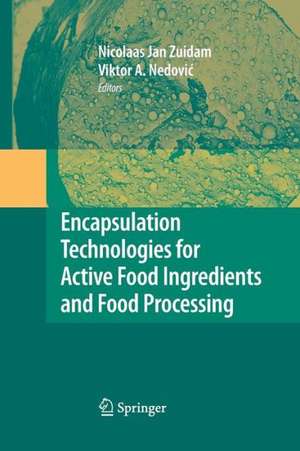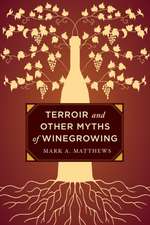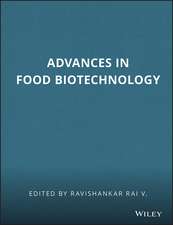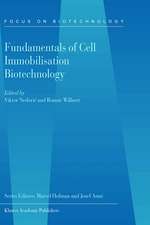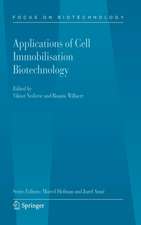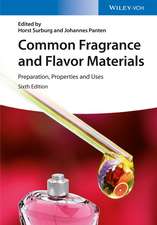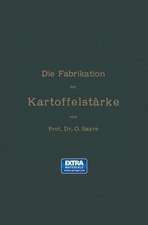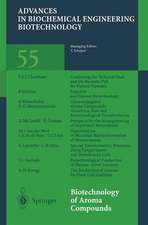Encapsulation Technologies for Active Food Ingredients and Food Processing
Editat de N.J. Zuidam, Viktor Nedovicen Limba Engleză Paperback – 29 noi 2014
This book provides a detailed overview of the encapsulation technologies available for use in food products, food processing, and food production. The book aims to inform those who work in academia or R&D about both the delivery of food compounds via encapsulation and food processing using immobilized cells or enzymes. The structure of the book is according to the use of encapsulates for a specific application. Emphasis is placed on strategy, since encapsulation technologies may change. Most chapters include application possibilities of the encapsulation technologies in specific food products or processes.
The first part of the book reviews general technologies, food-grade materials, and characterization methods for encapsulates.
The second part discusses encapsulates of active ingredients (e.g., aroma, fish oil, minerals, vitamins, peptides, proteins, probiotics) for specific food applications.
The last part describes immobilization technologies of cells and enzymes for use within food fermentation processes (e.g., beer, wine, dairy, meat), and food production (e.g., sugar conversion, production of organic acids or amino acids, hydrolysis of triglycerides).
Edited by two leading experts in the field, Encapsulation Technologies for Food Active Ingredients and Food Processing will be a valuable reference source for those working in the academia or food industry. The editors work in both industry or academia, and they have brought together in this book contributions from both fields.
| Toate formatele și edițiile | Preț | Express |
|---|---|---|
| Paperback (1) | 950.03 lei 6-8 săpt. | |
| Springer – 29 noi 2014 | 950.03 lei 6-8 săpt. | |
| Hardback (1) | 956.03 lei 6-8 săpt. | |
| Springer – 15 noi 2009 | 956.03 lei 6-8 săpt. |
Preț: 950.03 lei
Preț vechi: 1158.57 lei
-18% Nou
Puncte Express: 1425
Preț estimativ în valută:
181.81€ • 188.73$ • 151.60£
181.81€ • 188.73$ • 151.60£
Carte tipărită la comandă
Livrare economică 22 martie-05 aprilie
Preluare comenzi: 021 569.72.76
Specificații
ISBN-13: 9781489983497
ISBN-10: 148998349X
Pagini: 412
Ilustrații: XII, 400 p.
Dimensiuni: 155 x 235 x 22 mm
Greutate: 0.58 kg
Ediția:2010
Editura: Springer
Colecția Springer
Locul publicării:New York, NY, United States
ISBN-10: 148998349X
Pagini: 412
Ilustrații: XII, 400 p.
Dimensiuni: 155 x 235 x 22 mm
Greutate: 0.58 kg
Ediția:2010
Editura: Springer
Colecția Springer
Locul publicării:New York, NY, United States
Public țintă
ResearchDescriere
Consumers prefer food products that are tasty, healthy, and convenient. Encapsulation is an important way to meet these demands by delivering food ingredients at the right time and right place. For example, encapsulates may allow flavor retention, mask bad tasting or bad smelling components, stabilize food ingredients, and increase their bioavailability. Encapsulation may also be used to immobilize cells or enzymes in the production of food materials or products, such as fermentation or metabolite production.
This book provides a detailed overview of the encapsulation technologies available for use in food products, food processing, and food production. The book aims to inform those who work in academia or R&D about both the delivery of food compounds via encapsulation and food processing using immobilized cells or enzymes. The structure of the book is according to the use of encapsulates for a specific application. Emphasis is placed on strategy, since encapsulation technologies may change. Most chapters include application possibilities of the encapsulation technologies in specific food products or processes.
The first part of the book reviews general technologies, food-grade materials, and characterization methods for encapsulates.
The second part discusses encapsulates of active ingredients (e.g., aroma, fish oil, minerals, vitamins, peptides, proteins, probiotics) for specific food applications.
The last part describes immobilization technologies of cells and enzymes for use within food fermentation processes (e.g., beer, wine, dairy, meat), and food production (e.g., sugar conversion, production of organic acids or amino acids, hydrolysis of triglycerides).
Edited by two leading experts in the field, Encapsulation Technologies for Food Active Ingredients and Food Processing will be a valuable reference source for those working in the academia or food industry. The editors work in both industry or academia, and they have brought together in this book contributions from both fields.
This book provides a detailed overview of the encapsulation technologies available for use in food products, food processing, and food production. The book aims to inform those who work in academia or R&D about both the delivery of food compounds via encapsulation and food processing using immobilized cells or enzymes. The structure of the book is according to the use of encapsulates for a specific application. Emphasis is placed on strategy, since encapsulation technologies may change. Most chapters include application possibilities of the encapsulation technologies in specific food products or processes.
The first part of the book reviews general technologies, food-grade materials, and characterization methods for encapsulates.
The second part discusses encapsulates of active ingredients (e.g., aroma, fish oil, minerals, vitamins, peptides, proteins, probiotics) for specific food applications.
The last part describes immobilization technologies of cells and enzymes for use within food fermentation processes (e.g., beer, wine, dairy, meat), and food production (e.g., sugar conversion, production of organic acids or amino acids, hydrolysis of triglycerides).
Edited by two leading experts in the field, Encapsulation Technologies for Food Active Ingredients and Food Processing will be a valuable reference source for those working in the academia or food industry. The editors work in both industry or academia, and they have brought together in this book contributions from both fields.
Cuprins
Introduction Nicolaas Jan Zuidam & Viktor A. NedovicOverview of microencapsulates for use in food products or processes and methods to make them Nicolaas Jan Zuidam & Eyal Shimoni Materials for encapsulationChristine Wandrey, Artur Bartkowiak & Stephen E. Harding Characterisation methods of encapsulates:Zhibing Zhang, Daniel Law & Guoping Lian Encapsulation of aromaNicolaas Jan Zuidam & Emmanuel Heinrich Microencapsulation of omega-3 / fish oilChristiaan M. Beindorff and Nicolaas Jan ZuidamEncapsulation of iron and other micronutrients for food fortificationMichael B. Zimmermann & Erich J. Windhab Encapsulation of carotenoids Henelyta S. Ribeiro, Heike P. Schuchmann, Robert Engel, Elke Walz, Karlis BrivibaEncapsulation of enzymes and peptides Gabrie M.H. Meesters Encapsulation of probiotics for use in food productsVerica Manojlovic, Viktor A. Nedovic, Kasipathy Kailasapathy & Nicolaas Jan ZuidamBioprocess intensification of beer fermentation using immobilised cellsPieter Verbelen, Viktor A. Nedovic, Verica Manojlovic, Freddy Delvaux, Ida Leskosek-Cukalovic, Branko Bugarski & Ronnie WillaertImmobilisation of microbial cells for alcoholic and malo-lactic fermentation of wine and ciderYiannis Kourkoutas, Verica Manojlovic & Viktor A. NedovicImmobilisation of cells and enzymes for dairy or meat fermentation processesClaude P. Champagne, Byong H. Lee & Linda SaucierEncapsulates for food bioconversions and metabolite production< Véronique Breguet, Vojislav Vojinovic & Ian W. Marison
Notă biografică
Dr. Nicolaas Jan (Klaas-Jan) Zuidam is leading the skillbase group ‘Controlled Delivery of Food Actives’ and is a member of the management team of the Flavour Generation & Delivery department within Unilever Research and Development in Vlaardingen, The Netherlands. Since 1990, he has been working on encapsulation, respectively, in the area of pharmaceutics, gene therapy, laundry and foods. He is an author of more than 35 peer-reviewed articles and book chapters, and holds 2 patents.
Dr. Viktor A. Nedovic is an associate professor at the Department of Food Technology and Biochemistry, Faculty of Agriculture, University of Belgrade, Belgrade, Republic of Serbia. Since 1989, he has been working on immobilisation, co-immobilisation, encapsulation and bioreactor system design in the fields of food production and fermentation processes. He is an author of more than 70 peer-reviewed articles and book chapters. He has served as co-editor of two important books on cell immobilisation: Fundamentals of Cell Immobilisation Biotechnology (Kluwer Academic Publishers, 2004) and Applications of Cell Immobilisation Biotechnology (Springer, 2005).
Dr. Viktor A. Nedovic is an associate professor at the Department of Food Technology and Biochemistry, Faculty of Agriculture, University of Belgrade, Belgrade, Republic of Serbia. Since 1989, he has been working on immobilisation, co-immobilisation, encapsulation and bioreactor system design in the fields of food production and fermentation processes. He is an author of more than 70 peer-reviewed articles and book chapters. He has served as co-editor of two important books on cell immobilisation: Fundamentals of Cell Immobilisation Biotechnology (Kluwer Academic Publishers, 2004) and Applications of Cell Immobilisation Biotechnology (Springer, 2005).
Textul de pe ultima copertă
Consumers prefer food products that are tasty, healthy and convenient. Encapsulation is an important way to meet these demands by delivering food ingredients at the right time and right place. For example, encapsulates may allow flavour retention, mask bad tasting or bad smelling components, stabilize food ingredients and/or increase their bioavailability. Encapsulation may also be used to immobilise cells or enzymes in the production of food materials or products, such as fermentation or metabolite production.
This book provides a detailed overview of technologies for preparing and characterisation of encapsulates for food active ingredients to be used in food products, food processing or food production. The book is aimed to inform people who work in the academia or R&D of companies on delivery of food compounds via encapsulation and on food processing using immobilized cells or enzymes, with both a limited and an advantaged knowledge of the field. The structure of the book is according to the use of encapsulates for a specific application. Emphasis has been put to strategy, since encapsulation technologies may change. Most chapters include application possibilities of the encapsulation technologies in specific food products or processes.
The first part of the book reviews general technologies, food-grade materials and characterization methods for encapsulates.
The second part of the book, discusses encapsulates of active ingredients (i.e. aroma, fish oil, minerals, vitamins, peptides, proteins, probiotics) for specific food applications.
The last part of the book describes immobilization technologies of cells and enzymes for use within food fermentation processes (like beer, wine, dairy and meat) and food production (e.g., sugar conversion, production of organic acids or amino acids, and hydrolysis of triglycerides).
Edited by two leading experts in the field, Encapsulation Technologies for Food Active Ingredients and Food Processing will be a valuable reference source for those working in the academia or food industry. The editors work either in industry or university, and they have brought together in this book contributions from both fields.
Dr. Nicolaas Jan (Klaas-Jan) Zuidam is leading the skillbase group ‘Controlled Delivery of Food Actives’ and is a member of the management team of the Flavour Generation & Delivery department within Unilever Research and Development in Vlaardingen, The Netherlands. Since 1990, he has been working on encapsulation, respectively, in the area of pharmaceutics, gene therapy, laundry and foods. He is an author of more than 35 peer-reviewed articles and book chapters, and holds 2 patents.
Dr. Viktor A. Nedovic is an associate professor at the Department of Food Technology and Biochemistry, Faculty of Agriculture, University of Belgrade, Belgrade, Republic of Serbia. Since 1989, he has been working on immobilisation, co-immobilisation, encapsulation and bioreactor system design in the fields of food production and fermentation processes. He is an author of around 200 articles published in journals, books and proceedings. He has also served as co-editor of two important books on cell immobilisation: Fundamentals of Cell Immobilisation Biotechnology (Kluwer Academic Publisher, 2004) and Applications of Cell Immobilisation Biotechnology (Springer, 2005).
This book provides a detailed overview of technologies for preparing and characterisation of encapsulates for food active ingredients to be used in food products, food processing or food production. The book is aimed to inform people who work in the academia or R&D of companies on delivery of food compounds via encapsulation and on food processing using immobilized cells or enzymes, with both a limited and an advantaged knowledge of the field. The structure of the book is according to the use of encapsulates for a specific application. Emphasis has been put to strategy, since encapsulation technologies may change. Most chapters include application possibilities of the encapsulation technologies in specific food products or processes.
The first part of the book reviews general technologies, food-grade materials and characterization methods for encapsulates.
The second part of the book, discusses encapsulates of active ingredients (i.e. aroma, fish oil, minerals, vitamins, peptides, proteins, probiotics) for specific food applications.
The last part of the book describes immobilization technologies of cells and enzymes for use within food fermentation processes (like beer, wine, dairy and meat) and food production (e.g., sugar conversion, production of organic acids or amino acids, and hydrolysis of triglycerides).
Edited by two leading experts in the field, Encapsulation Technologies for Food Active Ingredients and Food Processing will be a valuable reference source for those working in the academia or food industry. The editors work either in industry or university, and they have brought together in this book contributions from both fields.
Dr. Nicolaas Jan (Klaas-Jan) Zuidam is leading the skillbase group ‘Controlled Delivery of Food Actives’ and is a member of the management team of the Flavour Generation & Delivery department within Unilever Research and Development in Vlaardingen, The Netherlands. Since 1990, he has been working on encapsulation, respectively, in the area of pharmaceutics, gene therapy, laundry and foods. He is an author of more than 35 peer-reviewed articles and book chapters, and holds 2 patents.
Dr. Viktor A. Nedovic is an associate professor at the Department of Food Technology and Biochemistry, Faculty of Agriculture, University of Belgrade, Belgrade, Republic of Serbia. Since 1989, he has been working on immobilisation, co-immobilisation, encapsulation and bioreactor system design in the fields of food production and fermentation processes. He is an author of around 200 articles published in journals, books and proceedings. He has also served as co-editor of two important books on cell immobilisation: Fundamentals of Cell Immobilisation Biotechnology (Kluwer Academic Publisher, 2004) and Applications of Cell Immobilisation Biotechnology (Springer, 2005).
Caracteristici
A reference for those working on food processing using immobilized cells or enzymes and on delivery of food compounds via encapsulation
Includes supplementary material: sn.pub/extras
Includes supplementary material: sn.pub/extras
